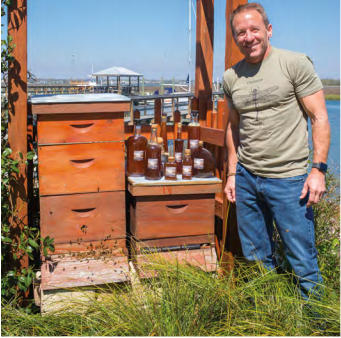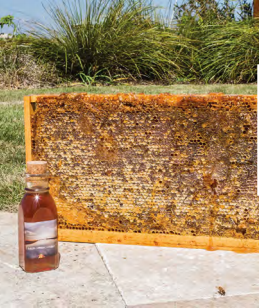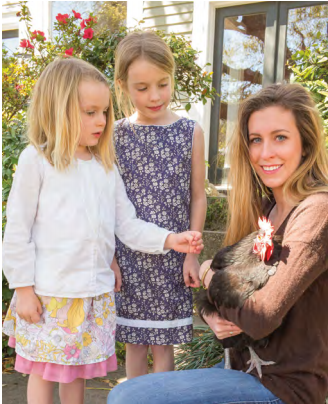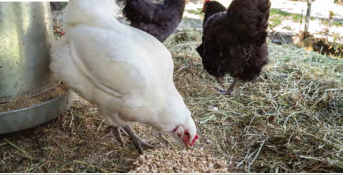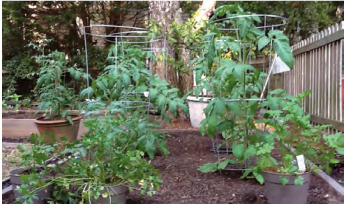Island Farmers
On our barrier islands, residents who take to the salty, sandy land often share its wealth with their neighbors. Ranging from the sweet treats of buzzing bees and the fruits of a backyard garden to temperamental chickens and their eggs, friends of farmers get to share in the goodness of growing. By Holly A. Fisher. Photos by Steve Rosamilia.
Seth Rice tends to his tomatoes
Busy with Bees
Visit Eric Dodson’s creekside home on Sullivan’s Island and he’s quick to pour you a small jar of honey complete with his “Back Creek Honey” custom label. Of the 10 gallons he collects each year from his backyard beehives, Dodson bottles most of it up and gives it away to neighbors and friends.
Eric Dodson shows off his bees’ bounty.
He started out three years ago with one hive and added another the next year. He keeps Italian bees, which are more docile — smarter seeing how the hives (80,000 bees in each) are only about 20 feet from the family’s swimming pool. Dodson say the trick is making sure the queen bee doesn’t mate out of the hive, or he could end up with a more aggressive breed of bee. It’s happened before, so he keeps a close eye on the queen, replacing her every two to three years, which is when her storage of eggs runs out and she’s ready to mate again.
Dodson is filled with fascinating bee facts like that. He tells me that the queen lays one egg every four to eight seconds, meaning she lays more than her body weight in eggs every 24 hours. Th e female bees are the workers, and the males die after mating. Th e hive is about 95 percent female and those bees are the ones collecting the pollen as well as fluttering their wings to fan the hive if it gets too hot.
Seth Rice inspects his fast growing tomato plants seedlings.
Th e females put in a lot of work in a short time. Their life cycle is just 28 days and each bee produce less than a quarter of a teaspoon of honey during her lifetime, Dodson explains. But with thousands of bees in a hive, the honey adds up. He usually harvests the honey three times a year — late spring, summer and again in the early fall. It’s plenty for his family with enough extra to share.
Lucienne and Stella Fletcher watch as Sydney Langley cuddles her mother’s last remaining chicken.
Dodson would love to see more people put hives in their backyards because of the incredible benefit bees have on the environment. Th e initial cost to start the hives was about $500, he says. And it’s not a large time investment. Th e bees really do all the work, and the family simply collects the bounty.
Adventures with Chickens
Last year Clydie De Brux thought it would be fun to surprise her daughter, a local kindergarten teacher, with four chicks. Her daughter was not amused, and the chicks ended up in her Sullivan’s Island home. “I was thinking in 18 weeks we would have some eggs and it would be so much fun,” she says. “But I had three roosters and a hen because you don’t know the sex until they grow up.” Still, she’d been bitten by the bug, so she hopped on Craigslist and found six hens for sale in Jedburg, creating a coop of one Bantam rooster and six huge Rhode Island Red hens.
Raising chickens has been an adventure for De Brux, especially when she had to load them into the car and drive to North Carolina to escape last fall’s Hurricane Matthew. Then she had to deal with a chicken-stealing opossum. And let’s not forget her monthly trip to Tractor Supply Co. for food, corn treats and pine shavings. “I could have bought 10 dozen eggs with what it’s cost me to preserve these chickens,” she laughs.
Each afternoon, De Brux or her husband collect the eggs from the coop — about four each day. It’s enough for them and a few to share with friends and her priest who lives around the corner. Plus, it makes for entertaining stories. “Never in my life would I have thought I would do this,” De Brux says. “It has elicited much conversation and humor: Clydie in her high heels goes out and tends to her chickens!”
Another Sullivan’s Islander with her share of chicken stories is Rita Langley. Langley bought six chicks four years ago, initially raising them in her dining room. Her daughter and some neighbor children came up with names like Apple, Miss Emily and, of course, Chicken. She’s now down to a single hen — shared between Langley and her neighbor who has a coop in her backyard. Neighbors consider Blackie a sort of free range community chicken.
Blackie hasn’t laid an egg in six months, Langley says. She’s stressed — and why wouldn’t she be? She’s the lone survivor. Langley’s daughter — who’s now off to college — and her 7-year-old neighbor are clamoring for additional chickens, but Langley’s not sure yet. She may pass the torch. A sign in her home reads: “I was normal a dozen chickens ago.”
With Veggies, Sharing is Caring
While keeping chickens is prohibited on Isle of Palms, residents are still putting their land to good use. Clay Cable has been gardening at his home since he moved to the island in 1957. A self-described “certified country boy,” Cable grew up in the hills of North Carolina and most of his family had farms and gardens, growing everything from cabbage and corn to apples and pears.
Half of Cable’s backyard is dedicated to his vegetable garden of cabbage, kale, potatoes and green onions plus his plum, pear and fi g trees. He and his wife eat from the garden, while sharing the extra with neighbors — often in a pick-your-own style perfect for this laid-back island community.
Also, on IOP, Seth Rice started out with several container gardens in his backyard. He’d buy five or six tomato plants only to have most of them shrivel up and die. So, he decided to grow the plants himself from seeds. He set up a makeshift greenhouse with growing lights in the room over the garage. Th e first year he planted 72 tomato seeds and all of them sprouted. He researched how to keep them going, and by that April had 72 good-sized tomato plants. “I got on the phone, Facebook, called friends and said, ‘Come on over and take your pick.’” A few friends traded tomatoes for collards they’d grown, and a veggie swap was born.
Over the last few years, Rice has continued growing his tomato plants from seed, increasing the number each year. He’s even growing a few heirlooms seeds his wife picked up during a visit to Thomas Jefferson’s Monticello. He keeps about a dozen plants and shares the rest. “I took them to work, I took them to anybody who was interested in growing them,” Rice says, who works at Whole Foods. “It’s a kind of feel-good thing.”
Rice compares his tomato project to raising his two daughters, now in their early 20s. “It reminds me of these little kids I bring up and then send them off to college and they go through their lives and they produce. It’s been fun and therapeutic. It’s good for the mind.”

